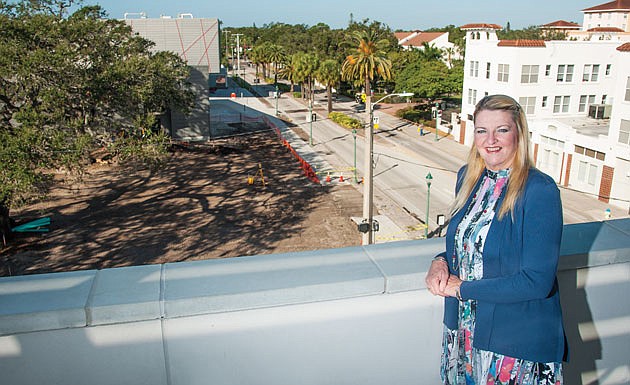- January 14, 2025
-
-
Loading

Loading

Why it matters: Ringling College of Art and Design continues to grow, in student enrollment, places for students to live, majors and programs.
Students at Sarasota's Ringling College of Art and Design aren't the only ones creating innovative projects.
In 2018, the school itself will unveil three new additions that will give students more educational and housing options, and help keep the college at the creative forefront among national art and design schools.
In the spring, Ringling is expected to complete its post-production facility. It's the final piece of a 36,000-square-foot, city block-sized complex. It offers 25,000 square feet of professional soundstage space and more than 5,000 square feet of post-production space available for both academic and commercial use. It's already attracted Hollywood names such as Kevin Smith and Justin Long to campus, and will help enhance Ringling's 10-year-old film major program. The soundstages and post-production space represent an investment of more than $10 million.
“This has turned into a wonderful home for us,” says Bradley Battersby, head of the college's film program. “It's amazing how much a built environment can contribute to your psychological well-being and the feeling that you're doing something special. The students' game has come up because they see how much we care about the program. They really try hard when they're on the soundstage. They feel that it's a big deal.”
More growth: In August, the college is expected to open its newest residence hall. It's a much needed addition, for Ringling is experiencing record enrollment levels — its student body is currently 1,464, up 16% from 1,262 in 2015-2016 — and has been maxed out on student housing.
“We have no more wiggle room,” says Tammy Walsh, Ringling's vice president for student life and dean of students. Ringling can accommodate 1,050 students in campus housing, and the new residence hall will add 181 beds. Though the college has no housing requirements, about 70% of students historically have chosen to live on campus. They like being close to their work at all hours of the day and may not have the transportation or funds required to live off campus. “That's part of what we are — we're a very residential campus, a creative living-learning community,” says Walsh.
The new $22 million residence hall will offer apartment-style living for upperclassmen. Forty-two four-bedroom units will include a shared common area and two bathrooms. There are also six two-bedroom units and a one-bedroom efficiency, plus a staff apartment.
While it will include typical dorm amenities like a laundry room, the yet-to-be-named residence hall will also feature some more unusual elements. “We want to build in working space for students,” says Walsh. “What's unique with us is we don't just build a lounge. We build a project room that will include a spray booth, things you don't see at most colleges.” There will also be a bike room offering covered storage for 56 bikes — something students requested.
On the academic front, the college's new virtual reality development major program will welcome its first class for the 2018-2019 academic year. Department head Jim McCampbell has been working on the major for the past couple of years, inspired by investments Facebook, Walt Disney Co., and other companies are making in virtual reality.
Because VR has almost endless potential applications, the degree program will prepare students for careers in everything from health care and advertising to architecture, education and entertainment. Courses will cover topics like visual scripting, concept development and VR development, and students will get hands-on experience working on projects with trailblazing VR companies like Flight School.
Ringling will be the first art and design college — and one of the first educational institutions in general — to offer a virtual reality degree program. “For students, it's going to mean a career path that is futuristic and forward-looking,” says McCampbell. “For the institution, it underscores our commitment to the fusion of art and technology. It presents a face to the world that demonstrates what that commitment is and that we ourselves are bold and not afraid to take creative chances, just like we ask of the artists who attend here.”